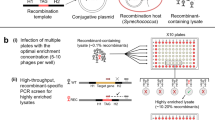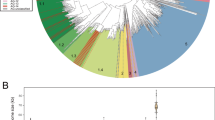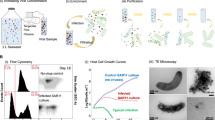Abstract
Viruses that infect marine cyanobacteria–cyanophages–often carry genes with orthologs in their cyanobacterial hosts, and the frequency of these genes can vary with habitat. To explore habitat-influenced genomic diversity more deeply, we used the genomes of 28 cultured cyanomyoviruses as references to identify phage genes in three ocean habitats. Only about 6–11% of genes were consistently observed in the wild, revealing high gene-content variability in these populations. Numerous shared phage/host genes differed in relative frequency between environments, including genes related to phosphorous acquisition, photorespiration, photosynthesis and the pentose phosphate pathway, possibly reflecting environmental selection for these genes in cyanomyovirus genomes. The strongest emergent signal was related to phosphorous availability; a higher fraction of genomes from relatively low-phosphorus environments–the Sargasso and Mediterranean Sea–contained host-like phosphorus assimilation genes compared with those from the N. Pacific Gyre. These genes are known to be upregulated when the host is phosphorous starved, a response mediated by pho box motifs in phage genomes that bind a host regulatory protein. Eleven cyanomyoviruses have predicted pho boxes upstream of the phosphate-acquisition genes pstS and phoA; eight of these have a conserved cyanophage-specific gene (PhCOG173) between the pho box and pstS. PhCOG173 is also found upstream of other shared phage/host genes, suggesting a unique regulatory role. Pho boxes are found upstream of high light-inducible (hli) genes in cyanomyoviruses, suggesting that this motif may have a broader role than regulating phosphorous-stress responses in infected hosts or that these hlis are involved in the phosphorous-stress response.
Similar content being viewed by others
Log in or create a free account to read this content
Gain free access to this article, as well as selected content from this journal and more on nature.com
or
Change history
20 August 2013
This article has been corrected since Advance Online Publication and a corrigendum is also printed in this issue
References
Benson DA, Karsch-Mizrachi I, Lipman DJ, Ostell J, Wheeler DL . (2006). GenBank. Nucleic Acids Res 34: D16–D20.
Bhaya D, Dufresne A, Vaulot D, Grossman A . (2002). Analysis of the hli gene family in marine and freshwater cyanobacteria. FEMS Microbiol Lett 215: 209–219.
Clokie MR, Shan J, Bailey S, Jia Y, Krisch HM, West S et al (2006). Transcription of a ‘photosynthetic’ T4-type phage during infection of a marine cyanobacterium. Environ Microbiol 8: 827–835.
Cock PJ, Antao T, Chang JT, Chapman BA, Cox CJ, Dalke A et al (2009). Biopython: freely available Python tools for computational molecular biology and bioinformatics. Bioinformatics 25: 1422–1423.
Coleman ML, Chisholm SW . (2007). Code and context: Prochlorococcus as a model for cross-scale biology. Trends Microbiol 15: 398–407.
Coleman ML, Chisholm SW . (2010). Ecosystem-specific selection pressures revealed through comparative population genomics. Proc Natl Acad Sci USA 107: 18634–18639.
Cornejo J, Willows RD, Beale SI . (1998). Phytobilin biosynthesis: cloning and expression of a gene encoding soluble ferredoxin-dependent heme oxygenase from Synechocystis sp. PCC 6803. Plant J 15: 99–107.
Dammeyer T, Bagby SC, Sullivan MB, Chisholm SW, Frankenberg-Dinkel N . (2008). Efficient phage-mediated pigment biosynthesis in oceanic cyanobacteria. Curr Biol 18: 442–448.
Dolganov NA, Bhaya D, Grossman AR . (1995). Cyanobacterial protein with similarity to the chlorophyll a/b binding proteins of higher plants: evolution and regulation. Proc Natl Acad Sci USA 92: 636–640.
Eddy SR . (1998). Profile hidden Markov models. Bioinformatics 14: 755–763.
Edgar RC . (2004). MUSCLE: multiple sequence alignment with high accuracy and high throughput. Nucleic Acids Res 32: 1792–1797.
Eisenhut M, Ruth W, Haimovich M, Bauwe H, Kaplan A, Hagemann M . (2008). The photorespiratory glycolate metabolism is essential for cyanobacteria and might have been conveyed endosymbiontically to plants. Proc Natl Acad Sci USA 105: 17199–17204.
Frias-Lopez J, Shi Y, Tyson GW, Coleman ML, Schuster SC, Chisholm SW et al (2008). Microbial community gene expression in ocean surface waters. Proc Natl Acad Sci USA 105: 3805–3810.
Funk C, Vermaas W . (1999). A cyanobacterial gene family coding for single-helix proteins resembling part of the light-harvesting proteins from higher plants. Biochemistry 38: 9397–9404.
Ghai R, Martin-Cuadrado AB, Molto AG, Heredia IG, Cabrera R, Martin J et al (2010). Metagenome of the Mediterranean deep chlorophyll maximum studied by direct and fosmid library 454 pyrosequencing. ISME J 4: 1154–1166.
Guindon S, Delsuc F, Dufayard JF, Gascuel O . (2009). Estimating maximum likelihood phylogenies with PhyML. Methods Mol Biol 537: 113–137.
Hasse D, Mikkat S, Thrun HA, Hagemann M, Bauwe H . (2007). Properties of recombinant glycine decarboxylase P- and H-protein subunits from the cyanobacterium Synechocystis sp. strain PCC 6803. FEBS Lett 581: 1297–1301.
Henn MR, Sullivan MB, Stange-Thomann N, Osburne MS, Berlin AM, Kelly L et al (2010). Analysis of high-throughput sequencing and annotation strategies for phage genomes. PLoS One 5: e9083.
Hsieh YJ, Wanner BL . (2010). Global regulation by the seven-component Pi signaling system. Curr Opin Microbiol 13: 198–203.
Ignacio-Espinoza JC, Sullivan MB . (2012). Phylogenomics of T4 cyanophages: lateral gene transfer in the ‘core’ and origins of host genes. Environ Microbiol 14: 2113–2126.
Kelly L, Huang KH, Ding HM, Chisholm SW . (2012). ProPortal: a resource for integrated systems biology of Prochlorococcus and its phage. Nucleic Acids Res 40: D632–D640.
Kettler GC, Martiny AC, Huang K, Zucker J, Coleman ML, Rodrigue S et al (2007). Patterns and implications of gene gain and loss in the evolution of Prochlorococcus. PLoS Genet 3: e231.
Labrie SJ, Frois-Moniz K, Osburne MS, Kelly L, Roggensack SE, Sullivan MB et al (2013). Genomes of marine cyanopodoviruses reveal multiple origins of diversity. Environ Microbiol 15: 1356–1376.
Lamarche MG, Wanner BL, Crepin S, Harel J . (2008). The phosphate regulon and bacterial virulence: a regulatory network connecting phosphate homeostasis and pathogenesis. FEMS Microbiol Rev 32: 461–473.
Letunic I, Bork P . (2011). Interactive Tree Of Life v2: online annotation and display of phylogenetic trees made easy. Nucleic Acids Res 39: W475–W478.
Lillig CH, Berndt C, Holmgren A . (2008). Glutaredoxin systems. Biochim Biophys Acta 1780: 1304–1317.
Lindell D, Jaffe JD, Coleman ML, Futschik ME, Axmann IM Rector T et al (2007). Genome-wide expression dynamics of a marine virus and host reveal features of co-evolution. Nature 449: 83–86.
Lindell D, Jaffe JD, Johnson ZI, Church GM, Chisholm SW . (2005). Photosynthesis genes in marine viruses yield proteins during host infection. Nature 438: 86–89.
Lindell D, Sullivan MB, Johnson ZI, Tolonen AC, Rohwer F, Chisholm SW . (2004). Transfer of photosynthesis genes to and from Prochlorococcus viruses. Proc Natl Acad Sci USA 101: 11013–11018.
Mann EL, Chisholm SW . (2000). Iron limits the cell division rate of Prochlorococcus in the eastern equatorial Pacific. Limnol Oceanogr 45: 1067–1076.
Mann NH, Clokie MR, Millard A, Cook A, Wilson WH, Wheatley PJ et al (2005). The genome of S-PM2, a ‘photosynthetic’ T4-type bacteriophage that infects marine Synechococcus strains. J Bacteriol 187: 3188–3200.
Martiny AC, Coleman ML, Chisholm SW . (2006). Phosphate acquisition genes in Prochlorococcus ecotypes: evidence for genome-wide adaptation. Proc Natl Acad Sci USA 103: 12552–12557.
Martiny AC, Huang Y, Li W . (2009). Occurrence of phosphate acquisition genes in Prochlorococcus cells from different ocean regions. Environ Microbiol 11: 1340–1347.
Millard AD, Gierga G, Clokie MRJ, Evans DJ, Hess WR, Scanlan DJ . (2010). An antisense RNA in a lytic cyanophage links psbA to a gene encoding a homing endonuclease. ISME J 4: 1121–1135.
Millard AD, Zwirglmaier K, Downey MJ, Mann NH, Scanlan DJ . (2009). Comparative genomics of marine cyanomyoviruses reveals the widespread occurrence of Synechococcus host genes localized to a hyperplastic region: implications for mechanisms of cyanophage evolution. Environ Microbiol 11: 2370–2387.
Monier A, Welsh RM, Gentemann C, Weinstock G, Sodergren E, Armbrust EV et al (2012). Phosphate transporters in marine phytoplankton and their viruses: cross-domain commonalities in viral-host gene exchanges. Environ Microbiol 14: 162–176.
Moutin T, Raimbault P . (2002). Primary production, carbon export and nutrients availability in western and eastern Mediterranean Sea in early summer 1996 (MINOS cruise). J Mar Syst 33: 273–288.
Muramatsu M, Hihara Y . (2012). Acclimation to high-light conditions in cyanobacteria: from gene expression to physiological responses. J Plant Res 125: 11–39.
Ostrowski M, Mazard S, Tetu SG, Phillippy K, Johnson A, Palenik B et al (2010). PtrA is required for coordinate regulation of gene expression during phosphate stress in a marine Synechococcus. ISME J 4: 908–921.
Pratt JT, Ismail AM, Camilli A . (2010). PhoB regulates both environmental and virulence gene expression in Vibrio cholerae. Mol Microbiol 77: 1595–1605.
Punta M, Coggill PC, Eberhardt RY, Mistry J, Tate J, Boursnell C et al (2012). The Pfam protein families database. Nucleic Acids Res 40: D290–D301.
R Development Core Team (2009). R: A Language and Environment for Statistical Computing. R Foundation for Statistical Computing: Vienna, Austria, ISBN 3-900051-07-0, URL http://www.R-project.org.
Rohwer F, Thurber RV . (2009). Viruses manipulate the marine environment. Nature 459: 207–212.
Sabehi G, Shaulov L, Silver DH, Yanai I, Harel A, Lindell D . (2012). A novel lineage of myoviruses infecting cyanobacteria is widespread in the oceans. Proc Natl Acad Sci USA 109: 2037–2042.
Santos-Beneit F, Rodriguez-Garcia A, Martin JF . (2011). Complex transcriptional control of the antibiotic regulator afsS in Streptomyces: PhoP and AfsR are overlapping, competitive activators. J Bacteriol 193: 2242–2251.
Scanlan DJ, Mann NH, Carr NG . (1993). The response of the picoplanktonic marine cyanobacterium Synechococcus species WH7803 to phosphate starvation involves a protein homologous to the periplasmic phosphate-binding protein of Escherichia coli. Mol Microbiol 10: 181–191.
Scanlan DJ, Ostrowski M, Mazard S, Dufresne A, Garczarek L, Hess WR et al (2009). Ecological genomics of marine picocyanobacteria. Microbiol Mol Biol Rev 73: 249–299.
Sharon I, Battchikova N, Aro EM, Giglione C, Meinnel T, Glaser F et al (2011). Comparative metagenomics of microbial traits within oceanic viral communities. ISME J 5: 1178–1190.
Steglich C, Futschik M, Rector T, Steen R, Chisholm SW . (2006). Genome-wide analysis of light sensing in Prochlorococcus. J Bacteriol 188: 7796–7806.
Storm P, Hernandez-Prieto MA, Eggink LL, Hoober JK, Funk C . (2008). The small CAB-like proteins of Synechocystis sp. PCC 6803 bind chlorophyll. In vitro pigment reconstitution studies on one-helix light-harvesting-like proteins. Photosynth Res 98: 479–488.
Su Z, Olman V, Xu Y . (2007). Computational prediction of Pho regulons in cyanobacteria. BMC Genomics 8: 156.
Sullivan MB, Coleman ML, Weigele P, Rohwer F, Chisholm SW . (2005). Three Prochlorococcus cyanophage genomes: signature features and ecological interpretations. PLoS Biol 3: e144.
Sullivan MB, Huang KH, Ignacio-Espinoza JC, Berlin AM, Kelly L, Weigele PR et al (2010). Genomic analysis of oceanic cyanobacterial myoviruses compared with T4-like myoviruses from diverse hosts and environments. Environ Microbiol 12: 3035–3056.
Sullivan MB, Lindell D, Lee JA, Thompson LR, Bielawski JP, Chisholm SW . (2006). Prevalence and evolution of core photosystem II genes in marine cyanobacterial viruses and their hosts. PLoS Biol 4: e234.
Sun SL, Chen J, Li WZ, Altintas I, Lin A, Peltier S et al (2011). Community cyberinfrastructure for Advanced Microbial Ecology Research and Analysis: the CAMERA resource. Nucleic Acids Res 39: D546–D551.
Suttle CA . (2007). Marine viruses—major players in the global ecosystem. Nat Rev Microbiol 5: 801–812.
Suziedeliene E, Suziedelis K, Garbenciute V, Normark S . (1999). The acid-inducible asr gene in Escherichia coli: transcriptional control by the phoBR operon. J Bacteriol 181: 2084–2093.
Tetu SG, Brahamsha B, Johnson DA, Tai V, Phillippy K, Palenik B et al (2009). Microarray analysis of phosphate regulation in the marine cyanobacterium Synechococcus sp. WH8102. ISME J 3: 835–849.
Thompson AW, Huang K, Saito MA, Chisholm SW . (2011a). Transcriptome response of high- and low-light-adapted Prochlorococcus strains to changing iron availability. ISME J 5: 1580–1594.
Thompson LR, Zeng Q, Kelly L, Huang KH, Singer AU, Stubbe J et al (2011b). Phage auxiliary metabolic genes and the redirection of cyanobacterial host carbon metabolism. Proc Natl Acad Sci USA 108: E757–E764.
Tolonen AC, Aach J, Lindell D, Johnson ZI, Rector T, Steen R et al (2006). Global gene expression of Prochlorococcus ecotypes in response to changes in nitrogen availability. Mol Syst Biol 2: 53.
Van Mooy BA, Rocap G, Fredricks HF, Evans CT, Devol AH . (2006). Sulfolipids dramatically decrease phosphorus demand by picocyanobacteria in oligotrophic marine environments. Proc Natl Acad Sci USA 103: 8607–8612.
Weigele PR, Pope WH, Pedulla ML, Houtz JM, Smith AL, Conway JF et al (2007). Genomic and structural analysis of Syn9, a cyanophage infecting marine Prochlorococcus and Synechococcus. Environ Microbiol 9: 1675–1695.
Williamson SJ, Rusch DB, Yooseph S, Halpern AL, Heidelberg KB, Glass JI et al (2008). The Sorcerer II Global Ocean Sampling Expedition: metagenomic characterization of viruses within aquatic microbial samples. PLoS ONE 3: e1456.
Wu J, Sunda W, Boyle EA, Karl DM . (2000). Phosphate depletion in the western North Atlantic Ocean. Science 289: 759–762.
Zeng Q, Chisholm SW . (2012). Marine viruses exploit their host’s two-component regulatory system in response to resource limitation. Curr Biol 22: 124–128.
Zinser ER, Lindell D, Johnson ZI, Futschik ME, Steglich C, Coleman ML et al (2009). Choreography of the transcriptome, photophysiology, and cell cycle of a minimal photoautotroph, Prochlorococcus. PLoS ONE 4: e5135.
Acknowledgements
We thank Mark Breidenbach (Berkeley), Quincey Justman (Harvard), John Chodera (Berkeley), Jessie Thompson, Paul Berube, Steve Biller, and Qinglu Zeng (MIT) and Maureen Coleman (U Chicago) for useful discussions, Matt Sullivan (U Arizona) for collection and isolation of phage and Sara Roggensack and Brianne Holmbeck (MIT) for phage DNA sample preparation. This work was supported by grants to SWC from The National Science Foundation (NSF) Biological Oceanography Section, the NSF Center for Microbial Oceanography Research and Education, the US Department of Energy-GTL and the Gordon and Betty Moore Foundation.
Author information
Authors and Affiliations
Corresponding author
Additional information
Supplementary Information accompanies this paper on The ISME Journal website
Supplementary information
Rights and permissions
About this article
Cite this article
Kelly, L., Ding, H., Huang, K. et al. Genetic diversity in cultured and wild marine cyanomyoviruses reveals phosphorus stress as a strong selective agent. ISME J 7, 1827–1841 (2013). https://doi.org/10.1038/ismej.2013.58
Received:
Revised:
Accepted:
Published:
Issue date:
DOI: https://doi.org/10.1038/ismej.2013.58
Keywords
This article is cited by
-
Environmental stress mediates groundwater microbial community assembly
Nature Microbiology (2024)
-
Genetic diversity of virus auxiliary metabolism genes associated with phosphorus metabolism in Napahai plateau wetland
Scientific Reports (2023)
-
Genetic engineering of marine cyanophages reveals integration but not lysogeny in T7-like cyanophages
The ISME Journal (2022)
-
Cyanophage Distribution Across European Lakes of the Temperate-Humid Continental Climate Zone Assessed Using PCR-Based Genetic Markers
Microbial Ecology (2022)
-
Metabolic and biogeochemical consequences of viral infection in aquatic ecosystems
Nature Reviews Microbiology (2020)



